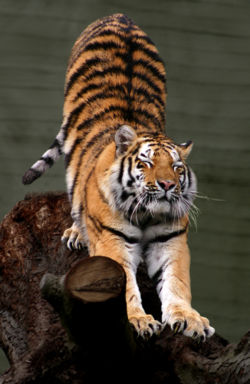Siberian tiger: Difference between revisions
imported>Daniel Mietchen (→See also: moved to Siberian_tiger/Related_Articles) |
imported>Igor Grešovnik |
||
| Line 18: | Line 18: | ||
==Endangerment== | ==Endangerment== | ||
Siberian tiger's [[IUCN]] status is considered critical. In the 1940 Siberian tigers were brought to near extinction, with only about 40 animals remaining in the wild. The population has recovered after protection from hunting and has increased to 150 to 200 in the mid nineties. The number continued to increase until 2005 when there were about 500 individuals in the wild, but has since faced a dramatic decline, which is attributed to rising poachind and continued habitat loss. The Russian population currently counts 300-400 individuals. There is also a small number of animals in north China, probably fewer than 50. | Siberian tiger's [[IUCN]] status is considered critical. In the 1940 Siberian tigers were brought to near extinction, with only about 40 animals remaining in the wild. The population has recovered after protection from hunting and has increased to 150 to 200 in the mid nineties. The number continued to increase until 2005 when there were about 500 individuals in the wild, but has since faced a dramatic decline, which is attributed to rising poachind and continued habitat loss. The Russian population currently counts 300-400 individuals. There is also a small number of animals in north China, probably fewer than 50. | ||
Until the 19th century, Siberian tigers inhabited wide areas of Western and Central Asia. These populations were known as Caspian tigers, although it is now considered, based on genetic research of their remains, that Caspian tiger does not form a separate subspecies. These western populations came to complete extinction in the 20th century due to hunting and deforestization. | |||
there is a scientifically managed captivity program for Siberian tigers, whose aim is to preserve genetic diversity. There are about 550 live animals in the zoos today, which are descended from 109 founders caught in the wild (mostly in 1950s and 1960s). These animals are registered in the International Tiger Studbook. | there is a scientifically managed captivity program for Siberian tigers, whose aim is to preserve genetic diversity. There are about 550 live animals in the zoos today, which are descended from 109 founders caught in the wild (mostly in 1950s and 1960s). These animals are registered in the International Tiger Studbook. | ||
Revision as of 10:14, 28 November 2009
The Siberian tiger (Panthera tigris altaica) is the largest non-extinct subspecies of tigers. It once inhabited large parts of Western and Central Asia and eastern Russia, but is currently found only in some regions of far eastern Siberia, where it is protected. The western population (extinct in the first half of the 20th century) was referred to as the Caspian tiger, although it is currently not considered a separate subspecies.
Characteristics
Male Siberian tigers weigh 190 to 310 kg and measure 2.7 to 3.3 m in total length. They are about 1.1 to 1.2 m tall in shoulders. Females are generally smaller, they weigh 100 to 170 kg and measure 2.4 to 2.75 m.
Fur of the Siberian tiger is thicker than with other species. In particular the winter coat is significantly thicker and longer, and is 40 to 50 mm long on the back, 70 to 100 mm on the neck and around 60 to 100 mm on the chest and abdomen. Winter coat has more expressive colors, but stripes appear less outlined due to the longer fur.
Behavior
The Siberian tiger occupies a very large territory. It may occupy the same territory for years if food sources are stable. When sources are scarce, it migrates for hundreds of kilometers. Both males and females mark their territory by urine and by scratching trees. Male tiger defends his territory against other mails, especially the important parts such as a boundary close to a female's territory or an area rich in food. The male are solitary and avoid other males. It allows other tigers to pass their territory, being more tolerant of females. The female is often accompanied by her cubs. Cubs start to hunt when they are less than two years old, but leave their mother at the age of 3 to 5 years. The female cubs stay with their mother longer and establish territories close to the original territory. Males leave earlier and travel farther, which makes them more vulnerable in in the early stage of independence. Although newborns are equally divided between male and female, there are usually 2 to 4 times more females than males among the adult population.
Endangerment
Siberian tiger's IUCN status is considered critical. In the 1940 Siberian tigers were brought to near extinction, with only about 40 animals remaining in the wild. The population has recovered after protection from hunting and has increased to 150 to 200 in the mid nineties. The number continued to increase until 2005 when there were about 500 individuals in the wild, but has since faced a dramatic decline, which is attributed to rising poachind and continued habitat loss. The Russian population currently counts 300-400 individuals. There is also a small number of animals in north China, probably fewer than 50.
Until the 19th century, Siberian tigers inhabited wide areas of Western and Central Asia. These populations were known as Caspian tigers, although it is now considered, based on genetic research of their remains, that Caspian tiger does not form a separate subspecies. These western populations came to complete extinction in the 20th century due to hunting and deforestization.
there is a scientifically managed captivity program for Siberian tigers, whose aim is to preserve genetic diversity. There are about 550 live animals in the zoos today, which are descended from 109 founders caught in the wild (mostly in 1950s and 1960s). These animals are registered in the International Tiger Studbook.
